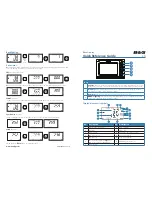
22
EN
4.5. ELECTRICAL CONNECTIONS
The sterilizer must be connected to a socket of the electric system having adequate capacity for the absorption of the device and properly earthed, in
accordance with laws and/or regulations in force.
The socket must be properly protected through magneto-thermal and differential circuit breakers having the following characteristics:
• Rated current I
n
16 A
• Residual current I
Dn
0.03 A
The manufacturer is not responsible for any damage caused by the installation of the sterilizer with unsuited and/or not properly
earthed electric systems.
Always connect the power cord directly to the power outlet.
Do not use extensions, adapters or other accessories.
4.6. DIRECT CONNECTION TO A CENTRALIZED DRAINING POINT
Use direct discharge connection ONLY when using a device without discharge tank recirculation filter and filling tank demineralisation
filter.
•
Remove the cap holding clip and the cap on the rear of the autoclave;
•
Fit the plastic tube on the elbow union (supplied);
•
Fit the union and then refit the clip;
•
Fasten the clamp (supplied) to the drain siphon;
•
Cut the tube to the right length and insert its free end into the centralized draining point union locking it with the dedicated ring nut.
Make sure that the tube is not bent, crushed or obstructed in any way.
The following diagram provides an indicative arrangement of the components:
1
At the centralized draining point;
3
Clamp;
2
Resting surface;
4
Drain siphon;
The position of the union of the centralized draining point must be lower than the resting surface of the sterilizer.
Otherwise, the tank may not be emptied correctly.
If an automatic filling system (external pump or solenoid valve, pure 100, pure 500) is connected, it is essential to use an overflow discharge
connection.
In case of fault or failure, this system allows any excess water produced by the automatic filling system to flow into the centralized draining point,
thus preventing flooding.
https://stomshop.pro/
















































